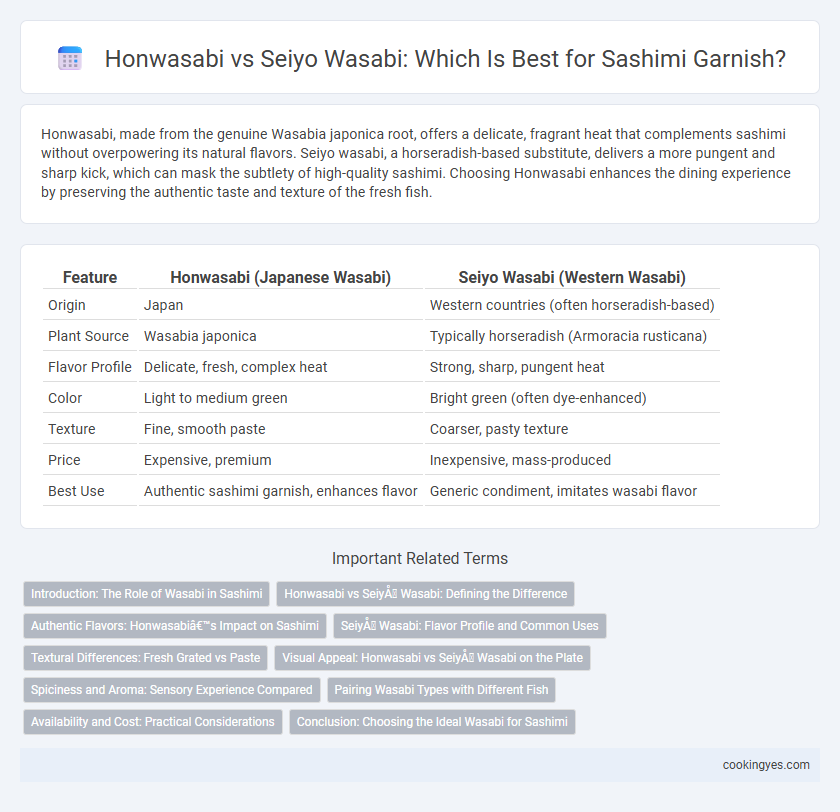Honwasabi, made from the genuine Wasabia japonica root, offers a delicate, fragrant heat that complements sashimi without overpowering its natural flavors. Seiyo wasabi, a horseradish-based substitute, delivers a more pungent and sharp kick, which can mask the subtlety of high-quality sashimi. Choosing Honwasabi enhances the dining experience by preserving the authentic taste and texture of the fresh fish.
Table of Comparison
| Feature | Honwasabi (Japanese Wasabi) | Seiyo Wasabi (Western Wasabi) |
|---|---|---|
| Origin | Japan | Western countries (often horseradish-based) |
| Plant Source | Wasabia japonica | Typically horseradish (Armoracia rusticana) |
| Flavor Profile | Delicate, fresh, complex heat | Strong, sharp, pungent heat |
| Color | Light to medium green | Bright green (often dye-enhanced) |
| Texture | Fine, smooth paste | Coarser, pasty texture |
| Price | Expensive, premium | Inexpensive, mass-produced |
| Best Use | Authentic sashimi garnish, enhances flavor | Generic condiment, imitates wasabi flavor |
Introduction: The Role of Wasabi in Sashimi
Wasabi serves as a crucial component in sashimi, enhancing flavor while offering antimicrobial properties that complement raw fish. Honwasabi, derived from the Wasabia japonica plant, provides a fresh, sharp heat with a complex aroma, elevating the traditional sashimi experience. Seiyo wasabi, often made from horseradish and mustard, delivers a more pungent, less nuanced heat, affecting the authenticity and flavor balance in sashimi garnishing.
Honwasabi vs Seiyō Wasabi: Defining the Difference
Honwasabi, or true wasabi (Wasabia japonica), offers a fresh, sharp heat and complex herbal aroma that enhances sashimi's delicate flavors, whereas Seiyo wasabi is a horseradish-based substitute with a more pungent, less refined taste profile. Honwasabi's scarcity and challenging cultivation make it a premium garnish prized for its authentic umami and subtle sweetness absent in Seiyo wasabi. Choosing Honwasabi over Seiyo wasabi elevates the sashimi experience by delivering a clean, lingering heat that complements raw fish without overpowering its natural taste.
Authentic Flavors: Honwasabi’s Impact on Sashimi
Honwasabi, derived from the Wasabia japonica plant cultivated in Japan's pristine mountain streams, offers an authentic, nuanced spiciness that enhances sashimi's delicate flavors without overpowering them. Unlike Seiyo wasabi, which is often a blend of horseradish, mustard, and green dye, Honwasabi provides a fresher, more complex aroma and a smooth, lingering heat that complements raw fish exquisitely. Its genuine presence elevates the sashimi experience, preserving the traditional taste profile highly valued in Japanese cuisine.
Seiyō Wasabi: Flavor Profile and Common Uses
Seiyo wasabi, often known as Western or horseradish wasabi, features a sharper, more pungent flavor compared to Honwasabi, delivering a strong heat that dissipates quickly. Commonly used as a garnish for sashimi, it enhances the delicate fish flavors without overpowering them, providing a spicy kick that complements soy sauce and pickled ginger. This type of wasabi is widely available and preferred in many Western sushi restaurants due to its bold taste and easier cultivation compared to traditional Honwasabi.
Textural Differences: Fresh Grated vs Paste
Fresh grated Honwasabi offers a fibrous, coarse texture that enhances sashimi with a vibrant, pungent bite, preserving the natural heat and aroma of the wasabi root. In contrast, Seiyo wasabi paste, typically made from horseradish and mustard, presents a smooth, uniform texture that delivers a milder, less complex flavor profile, suitable for even dispersion on delicate sashimi slices. The choice between these wasabi types directly impacts the sashimi experience by influencing both mouthfeel and flavor intensity.
Visual Appeal: Honwasabi vs Seiyō Wasabi on the Plate
Honwasabi presents a vibrant, natural green hue that enhances sashimi's visual appeal with its textured, fresh root appearance, contrasting sharply against delicate fish slices. Seiyo wasabi, often a pale green or muted color due to horseradish and food coloring blends, provides a consistent but less striking garnish look. The authentic vibrancy of Honwasabi complements sashimi plating by adding an artisanal, fresh aesthetic that elevates overall presentation quality.
Spiciness and Aroma: Sensory Experience Compared
Honwasabi, derived from the native Wasabia japonica, offers a sharp, lingering spiciness with a fresh, complex aroma that enhances the sashimi experience by complementing the delicate fish flavors. Seiyo wasabi, typically horseradish-based, delivers a more immediate and intense heat but lacks the depth and subtle floral notes found in Honwasabi, often overpowering the sashimi's natural taste. The sensory experience of sashimi is elevated by Honwasabi's balanced spiciness and refined aroma, making it the preferred choice for authentic garnishing.
Pairing Wasabi Types with Different Fish
Honwasabi, derived from the Wasabia japonica plant, offers a sharp, complex heat that pairs exceptionally well with fatty fish like toro and salmon, enhancing their rich flavors without overpowering them. Seiyo wasabi, typically a blend of horseradish, mustard, and green coloring, provides a milder, more straightforward heat suited for leaner fish such as flounder or squid, complementing their delicate taste. Choosing the right wasabi type for sashimi elevates the overall dining experience by balancing the texture and flavor profiles of each fish variety.
Availability and Cost: Practical Considerations
Honwasabi, sourced from the Wasabia japonica plant native to Japan, is renowned for its authentic flavor but is rare and expensive due to limited cultivation and high labor costs. Seiyo wasabi, often made from horseradish and mustard blends, is widely available and significantly cheaper, making it a practical choice for sashimi garnishing in many markets. The cost difference and accessibility influence chefs and consumers looking to balance traditional taste with budget and availability constraints.
Conclusion: Choosing the Ideal Wasabi for Sashimi
Honwasabi offers a smooth, authentic heat that enhances sashimi's delicate flavors without overpowering them, making it ideal for purists seeking traditional Japanese taste. Seiyo wasabi, often milder and more readily available, provides a less intense but complementary garnish suitable for broader palates and casual dining. Selecting the right wasabi depends on the desired flavor intensity and authenticity, with Honwasabi favored for genuine sashimi experiences and Seiyo wasabi for accessible everyday enjoyment.
Honwasabi vs Seiyō wasabi for sashimi garnish Infographic

 cookingyes.com
cookingyes.com